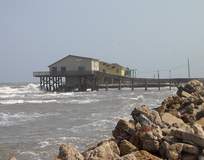 Back to More Sea Level
Rise Reports
Back to More Sea Level
Rise Reports
From Windsurfing Magazine 1998* Windsurfing in a Warmer World
By Jim Titus
The air is 50oF, the sea is 50oF, and you are treading water. At times like this, global warming may sound like a pretty good idea. But warmer temperatures are not the only way that the greenhouse effect will affect windsurfing.
For over a century scientists have calculated that the combustion of fossil fuels and resulting emissions of carbon dioxide could warm our planet by a mechanism known as "the greenhouse effect." The average global temperature has risen about 1oF since 1890 (see graph), and 1997 was the warmest year on record, according the Climate Research Unit of the Univerisity of East Anglia (United Kingdom). As ocean waters expand and mountain glaciers melt, sea level is rising more than one inch per decade along the Atlantic and Gulf Coasts, and the Environmental Protection Agency estimates that it could rise as much as four feet in the next century or so. Intense rainstorms have become 20 percent more frequent, according to Tom Karl of the National Oceanic and Atmospheric Administration.
Are these changes being caused by the greenhouse effect or by Mother Nature? Most formal assessments have concluded that both are to blame; but some scientists dispute this conclusion. WINDSURFING is not the place to rehash that debate, which has been covered extensively. (For two different views, see www.climatefacts.org and www.epa.gov/globalwarming.) But no other publication has considered what it all means for the windsurfing conditions of the 21st century.
How will global warming affect the wind? "In the topics, the trade winds are likely to become stronger," according to David Rind, of NASA’s Goddard Instititute for Space Studies in New York. The trade winds blow out of the northeast in the northern hemisphere, and out of the southeast in the southern hemisphere. These winds are driven partly by the earth’s rotation and partly because the evaporation near the equator causes the air to rise. New air has to come from somewhere to replace the equatorial air as it rises—and hence the trade winds. "Global warming would intensify the trade winds, because it would cause more evaporation," according to Dr. Rind.
"On the other hand, in the middle latitudes, winds are likely to decrease—especially during fall, winter, and spring," says Dr. Rind. The prevailing winds are caused largely by the temperature difference between cold polar areas and warmer areas to the south. "Global warming is expected to decrease this temperature difference, and as a result, winds will decrease." Average winds in summer would also be lighter, "but peak winds could be higher as thunderstorms become more frequent or severe."
Rising sea level deepens the water and erodes the shore. Along the Atlantic and Gulf Coasts, we have a virtually unbroken chain of barrier islands with shallow bays that are only 3-4 feet deep. Today, we can show our friends a few of the basics and let them play with our boards with little supervision. Although they will gradually be pushed downwind, they can wade upwind. Even more experienced sailors can find comfort in shallower water when we break a mast, lose the wind, or make minor adjustments. As the sea rises, the water will be over our heads in most of these bays—and more of us will be towing our friends back to land.
Shore erosion impairs windsurfing because of the engineering structures people use to hold back the sea. In Maryland alone, about three hundred miles of shoreline have already been armored with rocky revetments. It simply is not as fun to have to carry your rig and board over a wall to get into the water as it is to launch from a beach. When you want to take a rest, you can not simply leave your board on the beach—you have to dismantle it and carry it over the wall and back onto the land. During squalls, these structures are particularly hazardous. A stray gust comes along and you can rip your sail—or worse. During Tropical Storm Bertha, I saw someone sail a little too close to the wooden bulkhead at the Queene Anne Marina on Kent Island along the Eastern Shore of Chesapeake Bay. When he let go of his rig, the mast hit the wall and broke in two.
Global warming may also affect the waters in which some of us spend more time than we would like to admit. More intense rainstorms means that more pollutants will wash into our rivers, lakes, and bays. Algal blooms, fish kills, and diseases are more common with warm water temperatures. Increased drought and higher temperatures would allow jellyfish to invade Chesapeake Bay and other coastal waters earlier in the season.
Overall, global warming is likely to make windsurfing less attractive in most of the United States, while improving conditions in Hawaii, the Carribean, and other tropical areas. The places where conditions already are close to ideal will be even better. But in the continental United States, the conditions will be less favorable—except for those who like thunderstorms.
What we can do? To prepare for global warming, windsurfers need to take a stand against armoring bay shores with seawalls. In many states, surfers, and environmentalists have successfully stopped seawalls on the ocean, in favor of pumping sand onto those beaches. But seawalls continue to be built along bay beaches.
To reduce global warming, we need to reduce the amount of energy we consume and use solar energy where possible. Those of us with vans for transporting our equipment need to try harder not to use those vehicles for other trips. We need better racks for stacking several boards—have you ever taken two cars on a trip to the beach simply because it was the easiest way to carry all the boards?
And as we get older, we need to teach the fundamentals of sailing to our children before they are old enough to even think of asking for a ride on a craft powered by a two-cycle engine. A windsurfer is, after all, a solar-powered jet ski.
 Back to More Sea Level
Rise Reports
Back to More Sea Level
Rise Reports
 Environmental Song: When the
North Poles Melts
Environmental Song: When the
North Poles Melts
* This is actually the draft that I sent to Windsurfing magazine, which
was substantially condensed to fit the magazine’s format. But I can’t find
my copy of that issue. If you have a copy, please send me a copy and I’ll
post the text of the actual version. Note also: Windsurfing does not own
the copyright to this article because (a) they did not pay for it and (b)
it is probably not copyrightable by virtue of having been produced by a
federal government employee on subject matter related to his professional
duties. You own this article as much as anyone.